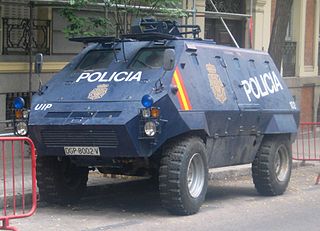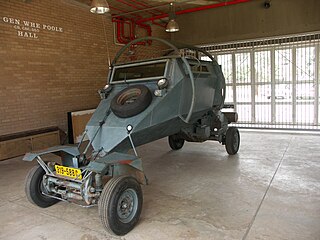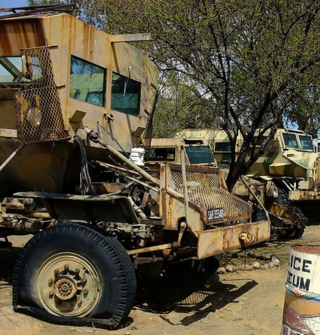| MAP75 Armoured Personnel Carrier | |
|---|---|
| Type | Armoured personnel carrier |
| Place of origin | Rhodesia |
| Service history | |
| In service | 1978–present |
| Used by | Rhodesia Zimbabwe |
| Wars | Rhodesian Bush War 1980 Entumbane clashes 1981 Entumbane uprising Mozambican Civil War Second Congo War |
| Specifications | |
| Mass | 11 tonnes (combat) 9.29 tonnes (empty) |
| Length | 7.2 m x 2.28 m |
| Width | 4.2 m Wb |
| Height | 2.84 m |
| Crew | 2+16 |
| Armor | 10 mm mild steel |
Main armament | one 7.62 mm, 12.7 mm or 14.5 mm machine guns |
Secondary armament | personal weapons through gunports |
| Engine | 6-cylinder 5.67L Benz diesel OM352 130 hp |
| Power/weight | hp/ton hp/tonne |
| Drive | 4 × 4 |
Operational range | 600 to 700 km |
| Maximum speed | 80 km/h/60 km/h km/h |
The MAP75 Armoured Personnel Carrier (a.k.a. MAP 'seven five') is a Rhodesian 4x4 heavy troop-carrying vehicle (TCV) first introduced in 1978 based on a Mercedes-Benz truck chassis. It remains in use with the Zimbabwe National Army.
The MAP75 consists of an all-welded body with a fully enclosed troop compartment built on a modified Mercedes-Benz 7.5 ton Series LA1113/42 truck chassis ('Rodef 75'). [1] Adapted from the Crocodile Armoured Personnel Carrier, the open-topped hull or 'capsule' is faceted at the sides, which were designed to deflect small-arms' rounds, and a flat deck reinforced by a v-shaped 'crush box' meant to deflect landmine blasts. Three inverted U-shaped 'roll bars' shorter than those on the Crocodile were fitted to protect the fighting compartment from being crushed in case the vehicle turned and roll over after a mine detonation. However, the reduced height of the 'roll bars' often hampered the crew's movements inside the vehicle, though the problem was rectified only in the post-war Zimbabwean versions by fitting higher bars. Access to the vehicle's interior is made by means of two medium-sized doors at the vertical hull rear whilst two square hatches placed low at the hull sides allowed for rapid debussing, an innovation that reflected the vehicle's combat offensive role.
The hull was made of ballistic 10mm mild steel plate; front windscreen and side windows had 40mm bullet-proof laminated glass.
Rhodesian MAP75s were usually armed with a FN MAG-58 7.62mm Light Machine Gun (LMG), sometimes installed on a locally produced one-man MG armoured turret to protect the gunner. Vehicles assigned to convoy escorting duties ('E-type') had a Browning M1919A4 7.62mm medium machine gun mounted on an open-topped, cylinder-shaped turret (dubbed 'the dustbin'). Twin Browning MG pintle mounts placed behind the driver’s compartment were often added on 'Seven fives' employed for 'externals'. The Zimbabwean vehicles after 1980 sported pintle-mounted Soviet-made 12.7mm and 14.5mm Heavy Machine Guns (HMG) instead.
The MAP75 TCV was employed late in the war by the elite units of the Rhodesian Security Forces – the Rhodesian African Rifles (RAR), the Rhodesian Light Infantry (RLI), [5] [6] the Selous Scouts [7] and the Rhodesian SAS – on Fireforce operations and on their cross-border covert raids ('externals') against ZIPRA and ZANLA guerrilla bases in the neighboring Countries, [8] such as the September 1979 raid on the ZANLA's New Chimoio base in Mozambique (Operation Miracle). [9]
After independence, the MAP75 entered service with the Zimbabwe National Army (ZNA) in early 1980 and equipped both the 1st and 2nd Battalions, RAR, which participated in the large military exercises conducted at Somabula Plain, Matabeleland that same year. ZNA's 'Seven Fives' were thrown into action in November 1980 against ZIPRA troops at the 1st Battle of Entumbane and later at the February 1981 2nd Battle of Entumbane (near Bulawayo, Matabeleland), and later again after February 1982 by helping to put down the Super-ZAPU insurgency in Matabeleland. During the Mozambican Civil War, 'Seven Fives' were also employed by the ZNA forces in Mozambique guarding the Mutare-Beira oil pipeline in 1982-1993 from RENAMO guerrilla attacks. The MAP75 served with the ZNA contingent sent to the Democratic Republic of Congo during the Second Congo War from 1998 to 2002. [10]

The Selous Scouts was a special forces unit of the Rhodesian Army that operated during the Rhodesian Bush War from 1973 until the reconstitution of the country as Zimbabwe in 1980. It was mainly responsible for infiltrating the black majority population of Rhodesia and collecting intelligence on insurgents so that they could be attacked by regular elements of the security forces. The unit did this by forming small teams that posed as insurgents and usually included captured insurgents. Over time, the Selous Scouts increasingly attacked insurgents themselves and operated in the countries that neighboured Rhodesia.

The Rhodesian Bush War, also called the Second Chimurenga as well as the Zimbabwean War of Liberation, was a civil conflict from July 1964 to December 1979 in the unrecognised country of Rhodesia.

The Zimbabwe National Army (ZNA) is the primary branch of the Zimbabwe Defence Forces responsible for land-oriented military operations. It is the largest service branch under the Zimbabwean Joint Operations Command (JOC). The modern army has its roots in the Rhodesian Army, which was raised between 1963 and 1964 after the breakup of the Federation of Rhodesia and Nyasaland. A Joint High Command created in March 1980 to oversee integration of the formerly belligerent Rhodesian Security Forces, Zimbabwe African National Liberation Army (ZANLA), and the Zimbabwe People's Revolutionary Army (ZIPRA) officially established the Zimbabwe National Army in late 1980, nearly a year after the end of the Rhodesian Bush War.

The T17E1 Armoured Car was an American armored car manufactured during the Second World War. It saw service with British and other Commonwealth forces during the war under the name Staghound, but was never used on the front line by US forces. A number of other countries used the Staghound after the war; some vehicles continued to serve until the 1980s.

Grey's Scouts were a Rhodesian mounted infantry unit raised in July 1975 and named after George Grey, a British soldier and governor. Based in Salisbury it patrolled Rhodesia's borders during the Rhodesian Bush War, and then became a regiment of the Special Forces of Zimbabwe in June 1980. It was totally disbanded in July 1986 because of a lack of resources.

The military history of Zimbabwe chronicles a vast time period and complex events from the dawn of history until the present time. It covers invasions of native peoples of Africa, encroachment by Europeans, and civil conflict.

The Thyssen Henschel UR-416 is a German armoured personnel carrier, first introduced in 1969 and based on the body of the Mercedes-Benz Unimog light truck.

The Rhodesian Armoured Corps, nicknamed the "Black Devils" — was the only standing armoured battalion of the Rhodesian Security Forces. During World War II, it took part in the Allied Spring 1945 offensive and the Battle of Monte Cassino as part of South Africa's 6th Armoured Division. The unit was among the first to enter a liberated Florence in July 1944. Prior to 1963, its crews were trained in the United Kingdom or Aden Colony and were known as the "Selous Scouts" under the Federation of Rhodesia and Nyasaland. After Rhodesia's Unilateral Declaration of Independence, maintaining the armoured vehicle fleet became a responsibility of the Rhodesian Light Infantry until Major Bruce Rooken-Smith reactivated the former Rhodesian Armoured Car Regiment in 1972. During the Rhodesian Bush War, the regiment fought in several major campaigns and battles, particularly Operation Miracle in September 1979. It was superseded by the new Zimbabwe Armoured Corps between 1980 and 1981.

The Rhodesian Security Forces were the military forces of the Rhodesian government. The Rhodesian Security Forces consisted of a ground force, the Rhodesian Air Force, the British South Africa Police, and various personnel affiliated to the Rhodesian Ministry of Internal Affairs. Despite the impact of economic and diplomatic sanctions, Rhodesia was able to develop and maintain a potent and professional military capability.

The Pookie MRAP vehicle was created to deal with the constant mining of roadways during the Rhodesian Bush War.

The Leopard Security Vehicle is an unusual land-mine protected APC used by the Rhodesian Government and civilian population during the 1964-1979 Rhodesian Bush War. It offered basic but necessary protection against mine attack through the use of a V-hull.
The Gazelle FRV or Fast Reconnaissance Vehicle is a 4×4 infantry fighting vehicle (IFV) built for reconnaissance on the chassis of the Mercedes-Benz Unimog light truck developed by Zimbabwe in the early 1980s.

The Mine Protected Combat Vehicle – MPCV was a Rhodesian 4×4 Infantry fighting vehicle (IFV), first introduced in 1979 and based on the body of the Mercedes-Benz Unimog light truck. It remains in use with the Zimbabwe National Army.
The Bullet Troop-Carrying Vehicle (TCV) is a light 4x4 infantry fighting vehicle (IFV) developed by Rhodesia in the late 1970s based on the body of the Mercedes-Benz Unimog light truck.
The Crocodile Armoured Personnel Carrier or "Croc" is a Rhodesian armoured personnel carrier first introduced in 1977 and based on Japanese commercial heavy-duty trucks' chassis. It remains in use with the Zimbabwe National Army (ZNA).
The MAP45 Armoured Personnel Carrier is a Rhodesian/Zimbabwean 4x4d heavy troop-carrying vehicle (TCV) first introduced in 1978 based on a Mercedes-Benz truck chassis. It remains in use with the Zimbabwe National Army.
The 1981 Entumbane uprising, also known as the Battle of Bulawayo or Entumbane II, occurred between 8 and 12 February 1981 in and around Bulawayo, Zimbabwe amid political tensions in the newly independent state. Zimbabwe People's Revolutionary Army (ZIPRA) guerrillas, mainly in the city's western suburb of Entumbane, rebelled, creating a situation that threatened to develop into a fresh civil war, barely a year after the end of the Bush War. The Rhodesian African Rifles (RAR) and other white-commanded elements of the former Rhodesian Security Forces, fighting for the Zimbabwean government as part of the new Zimbabwe National Army, put down the uprising. Groups of Zimbabwe African National Liberation Army (ZANLA) fighters attacked both ZIPRA and the government forces during the revolt, which followed a smaller outbreak of fighting between guerrillas in November 1980.

The Hippo is a South African armoured personnel carrier. Specially designed to be mine resistant, it can carry ten infantrymen and a crew of two. The vehicle's remote-operated turret mounts dual 7.62mm machine guns, but like other improvised fighting vehicles, it is only lightly protected against ballistic threats.
Zimbabwe Defence Industries (Pty) Ltd (ZDI) is a state-owned Zimbabwean arms manufacturing and procurement company headquartered in Harare, with a primary focus on sporting and military ammunition. In the past it has also manufactured mortar rounds, land mines, and light armoured fighting vehicles such as the Gazelle FRV. During the late 1990s, ZDI was involved in brokering major arms deals between China and other African governments such as the Republic of the Congo. The subsequent economic depression in Zimbabwe, as well as the collapse of the Zimbabwean dollar against major world currencies, have forced ZDI to limit its activity to exporting second-hand equipment from the Zimbabwe Defence Forces.